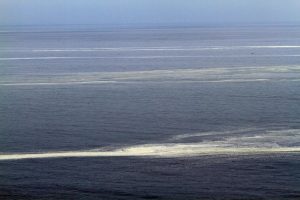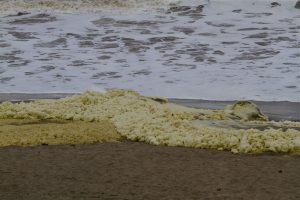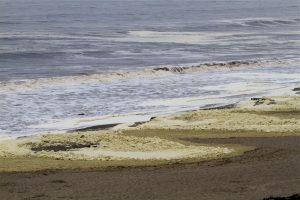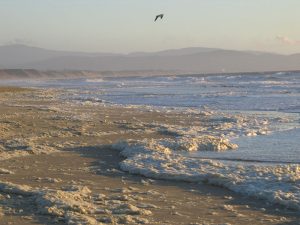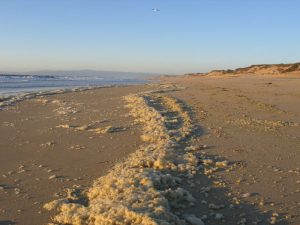This month there was a large increase in the dinoflagellate Akashiwo sanguinea in Monterey Bay.
While not toxic, this marine plankton species has the ability to discolor the water and also produce a surfactant foam. The highest concentrations occurred between the Pajaro River and Capitola Beach. You may remember the 2007 bloom of Akashiwo sanguinea that coated the feathers of many birds in the Monterey Bay area, causing them distress. We have not encountered birds in distress from the current event, however – as a reminder – if you see a live bird in distress, please call: in Santa Cruz County – Native Animal Rescue (831) 462-0726, and in Monterey County – Monterey County SPCA Wildlife Center (831) 264-5427.
If you would like more information about the current event there is a recent Santa Cruz Sentinel article available at this link: http://www.santacruzsentinel.com/environment-and-nature/20160916/monterey-bay-red-tide-and-accompanying-foam-not-toxic-expert-says
This information above was provided by Cori Gibble to BeachCOMBERS and MBNMS.
From October 13-16 a foul, sickly sweet stench pervaded the coastal towns of Capitola and Aptos. The foam generated by wave action and being blown onto shore was decaying and creating a noxious odor that could be easily smelled 1 mile inland. The smell caused residents to close windows and doors in their homes over the weekend. The concurrent storm did little to lessen the stench. Odiferous conditions began to improve by October 17th.
Dr. Raphael Kudela, Professor of Ocean Sciences at UCSC and and expert on algal blooms, said “The foam itself is caused by senescence of the bloom and then vigorous wave action. We found with both lab and field samples that the red tide by itself won’t produce foam (even when you strongly agitate the water)–the cells have to be unhealthy. The recent storm may wash the bloom out, particularly if there’s upwelling that would shift things back to diatoms, but it’s also possible that it will just increase the foam (more wave action, more unhealthy cells).”
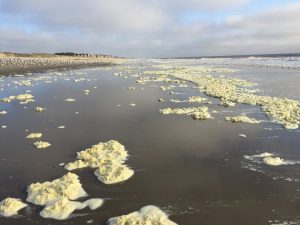
The photos of sea foam (shown below) were taken by Boots McGhee at La Selva Beach in October.
Akashiwo is the word for ‘red tide’ in Japanese, and this genus of marine dinoflagellate is known for dense algal blooms that can create red waters nearshore. This dinoflagellate lacks a thick cellulose wall, and can reproduce asexually, generating high densities in the water column.
Akashiwo sanguinea is relatively large and easily recognizable when looking at water samples under the microscope. This species can produce mycosporine-like amino acids (MAAs) that are water-soluble surfactants, which can reduce surface tension and acts, in a way, like a detergent. This surfactant can cause bird feathers to lose their ability to repel water, and in turn might lead to hypothermia. A paper by Jessup et al. (2009) discussing this can be found here.
The following is the abstract of that paper: “In November-December 2007 a widespread seabird mortality event occurred in Monterey Bay, California, USA, coincident with a massive red tide caused by the dinoflagellate Akashiwo sanguinea. Affected birds had a slimy yellow-green material on their feathers, which were saturated with water, and they were severely hypothermic. We determined that foam containing surfactant-like proteins, derived from organic matter of the red tide, coated their feathers and neutralized natural water repellency and insulation. No evidence of exposure to petroleum or other oils or biotoxins were found. This is the first documented case of its kind, but previous similar events may have gone undetected. The frequency and amplitude of red tides have increased in Monterey Bay since 2004, suggesting that impacts on wintering marine birds may continue or increase.”
